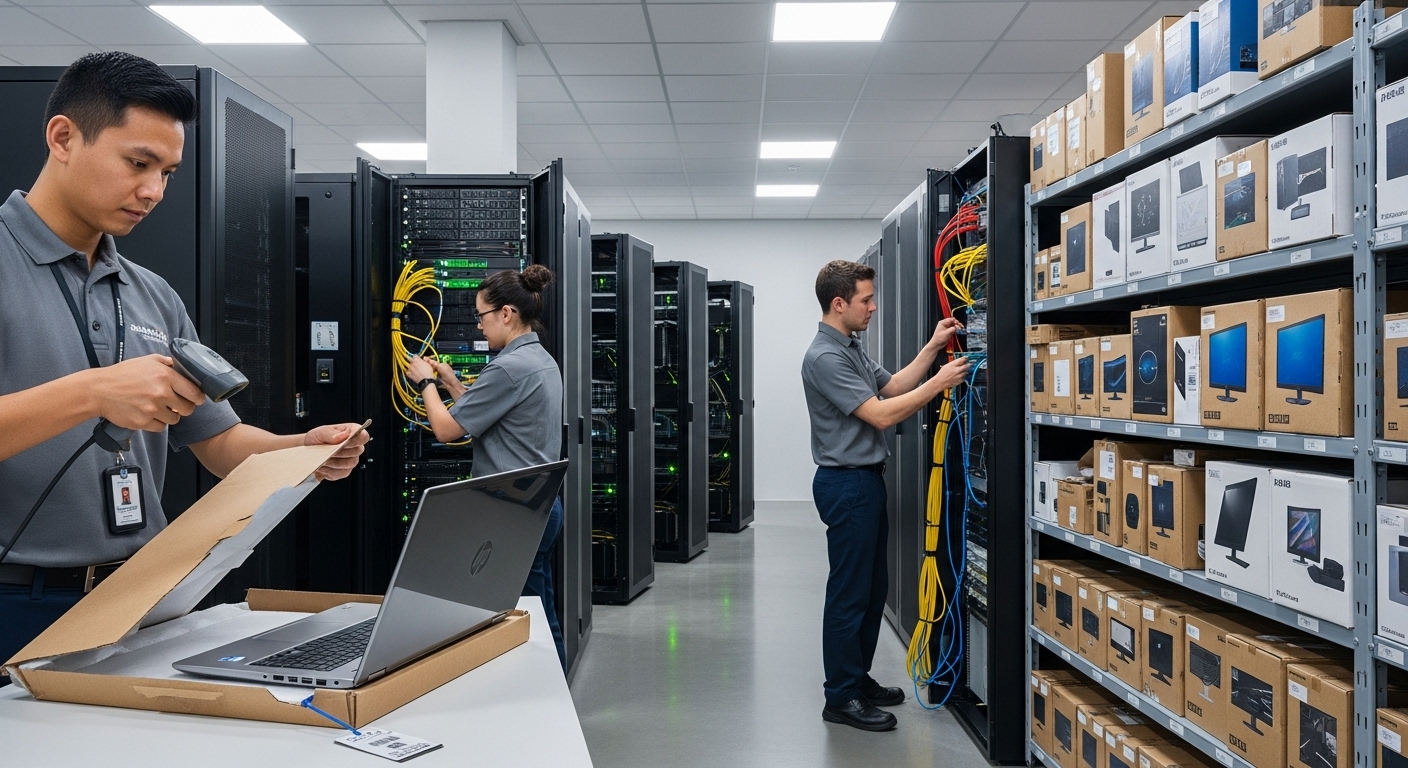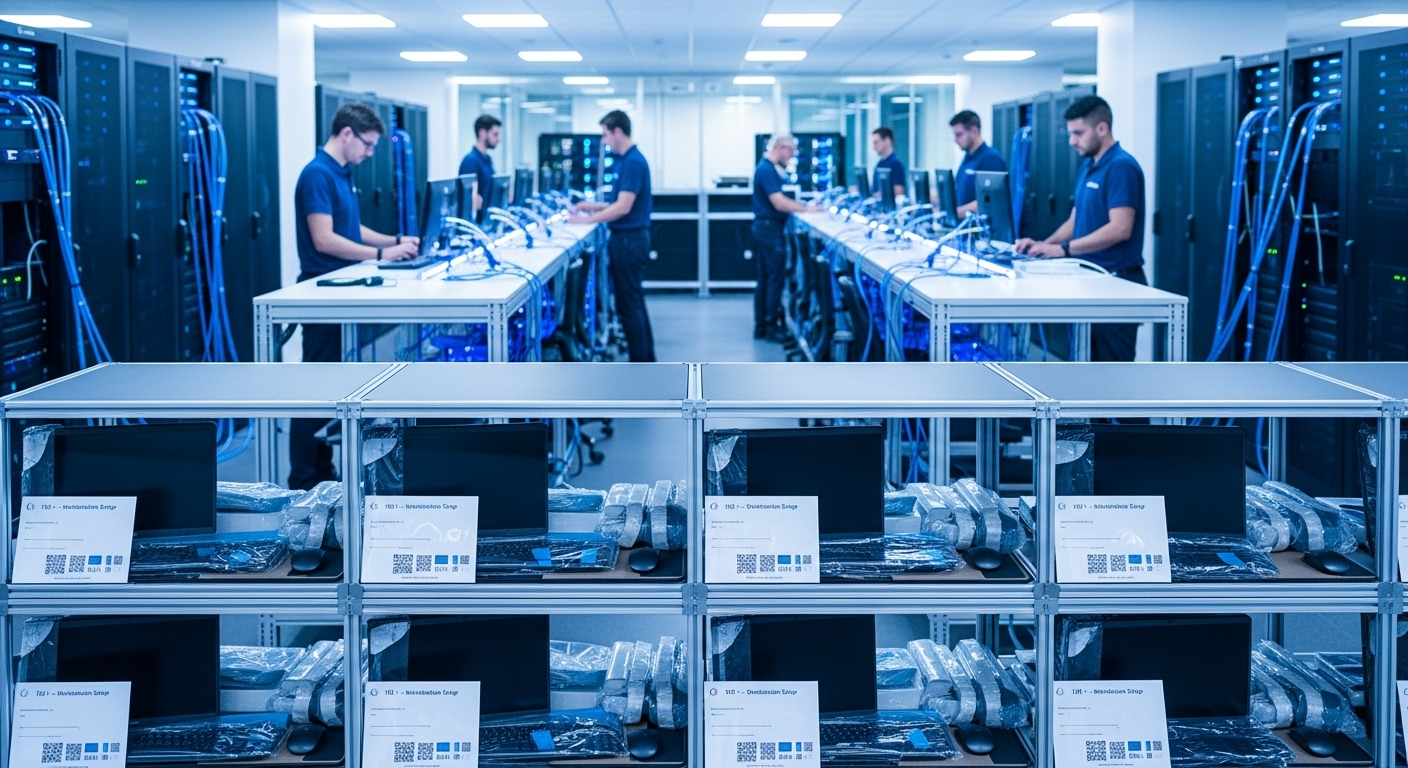In today’s fast-paced business environment, treating IT setup as a mere shopping list is a recipe for inefficiency and risk. The modern workplace, whether fully on-site, remote, or hybrid, demands a more holistic and strategic approach. This is where a full-stack framework comes into play—an integrated methodology that views information technology not as a collection of devices, but as a complete lifecycle. This framework spans from the initial thought of purchasing a device to its final, secure disposal. It’s a strategic shift from reactive problem-solving to proactive system building. Recent trends show that companies focusing on the entire IT asset journey are better equipped to handle security threats, scale operations, and manage costs effectively. This guide breaks down the full-stack framework into its critical components. We will explore how to build a procurement strategy that looks beyond the initial price, master the complex logistics of deployment, embed security from day one, and plan for a device’s end-of-life before it even leaves the box. By adopting this comprehensive view, businesses can transform their IT infrastructure from a necessary expense into a powerful strategic asset.
Strategic procurement: beyond the price tag
Effective IT begins long before a device is turned on; it starts with strategic procurement. This process transcends the simple act of buying hardware at the lowest cost. Instead, it focuses on the Total Cost of Ownership (TCO), a metric that encompasses not just the purchase price but also the costs of deployment, maintenance, support, and eventual disposal. A forward-thinking procurement strategy involves standardizing hardware models across the organization. While it might seem restrictive, standardization dramatically simplifies management and support. IT teams become experts on a limited set of devices, leading to faster troubleshooting and resolution. It also allows for bulk purchasing, which can unlock significant discounts and build stronger vendor relationships. Strong vendor management is another pillar of strategic procurement. This isn’t just about negotiating prices; it’s about partnering with suppliers who can guarantee stock, provide reliable support, and offer insights into future technology roadmaps. This partnership ensures that your hardware choices align with your company’s long-term growth and scalability plans. Furthermore, modern procurement must consider sustainability and supply chain resilience. Choosing energy-efficient hardware reduces operational costs and supports corporate social responsibility goals. Evaluating a vendor’s supply chain can mitigate risks associated with global disruptions, ensuring that critical hardware is available when needed. By shifting the focus from short-term savings to long-term value, strategic procurement lays a robust and cost-effective foundation for the entire IT ecosystem.
Deployment logistics: from pallet to plug-in
Once hardware arrives, the logistical challenge of deployment begins. This phase is a complex ballet of coordination, configuration, and physical installation that, if managed poorly, can lead to significant delays and disruptions. The first step in successful deployment is meticulous asset management. Every single piece of equipment, from a laptop to a monitor, should be unboxed, inspected, and assigned a unique asset tag that is immediately logged into a central inventory system. This foundational step provides critical visibility and control over the company’s hardware assets from the moment they enter the building. Following tagging, the focus shifts to configuration. Modern deployment strategies leverage zero-touch provisioning tools to automate the setup process. Instead of manually configuring each device, IT teams create a standardized software image that includes the operating system, security policies, and core business applications. When a user powers on a new device for the first time, it automatically connects to the management service and configures itself, saving countless hours of manual labor. The physical logistics are equally critical. This requires close collaboration with facilities managers, office designers, and network engineers to ensure that every workspace has the necessary power, data ports, and network connectivity. A detailed project plan with clear timelines, stakeholder responsibilities, and contingency plans is essential to orchestrate this process smoothly, especially during a new office build-out or large-scale refresh.
Security by design: embedding protection from the start
In the modern threat landscape, treating cybersecurity as an add-on is a critical vulnerability. The full-stack framework insists on a ‘security by design’ approach, where protective measures are woven into the IT infrastructure from the earliest stages of procurement and deployment. This proactive stance is far more effective and efficient than trying to bolt on security after the fact. It begins during the procurement phase by selecting hardware with built-in security features, such as hardware-based encryption and secure boot capabilities. During deployment, security becomes a core part of the configuration process. Every device should be set up with mandatory full-disk encryption, a robust endpoint protection platform (antivirus and anti-malware), and a properly configured software firewall before it is handed to a user. For businesses operating in a hybrid or remote model, Mobile Device Management (MDM) solutions are non-negotiable. An MDM platform allows IT to enforce security policies, manage applications, and remotely wipe a device if it is lost or stolen, protecting sensitive company data regardless of its physical location. Furthermore, network security must be integrated with device deployment. This includes configuring secure Wi-Fi protocols (like WPA3), segmenting networks to isolate critical systems, and implementing strong Identity and Access Management (IAM) controls. By making security a foundational element of the setup process, organizations create a resilient posture that significantly reduces their attack surface from day one.
User enablement: the crucial final mile of deployment
The technical deployment of a device is only half the battle; the process is not complete until the end-user is comfortable, confident, and productive. This ‘final mile,’ known as user enablement, is a critical and often overlooked stage of the IT setup process. A successful enablement strategy transforms a potentially stressful transition into a positive experience, fostering a better relationship between employees and the IT department. It starts with structured onboarding. Instead of just leaving a box on a desk, a proper handover should include a brief, hands-on orientation. This session should cover essential functions, key security practices (like identifying phishing attempts), and how to connect to company resources. Providing clear, concise, and easily accessible documentation is paramount. A well-organized internal knowledge base with step-by-step guides, FAQs, and video tutorials empowers users to solve common problems independently, reducing the burden on the support desk. This self-service approach not only improves efficiency but also gives employees a greater sense of autonomy. Establishing clear and simple channels for requesting IT support is also essential. Whether through a ticketing system, a dedicated chat channel, or a phone number, users need to know exactly where to turn when they need help. A seamless and positive first interaction with IT support can set the tone for an employee’s entire experience with technology at the company, directly impacting their productivity and job satisfaction.
Lifecycle management: planning for the end from the beginning
A truly comprehensive IT framework accounts for the entire lifespan of an asset, including its retirement. IT Asset Lifecycle Management is the practice of planning for a device’s end-of-life (EOL) from the moment it is procured. This proactive approach avoids the security risks, environmental impact, and financial inefficiencies associated with hoarding obsolete technology. The process begins by establishing a standardized hardware refresh cycle, typically three to five years for laptops and desktops. A predictable refresh schedule ensures that employees are always equipped with reliable and performant tools, preventing productivity losses caused by aging hardware. It also simplifies budgeting by making capital expenditures for IT predictable. When a device reaches its scheduled EOL, the decommissioning process must be handled with extreme care. The most critical step is secure data sanitization. Simply deleting files is insufficient; the storage drive must be wiped using certified data destruction software to ensure that no sensitive company or client information can ever be recovered. For devices that stored highly confidential data, physical destruction of the hard drive may be necessary. Responsible disposal is the final piece of the puzzle. E-waste is a significant environmental concern, and companies have a responsibility to dispose of old hardware ethically. Partnering with a certified e-waste recycling vendor ensures that devices are disposed of in compliance with environmental regulations and that valuable materials are recovered. This not only fulfills corporate social responsibility but also protects the company from potential fines associated with improper disposal.
The integrated tech stack: software deployment and management
While hardware forms the physical backbone of an IT infrastructure, software is the engine that drives productivity. A full-stack approach requires a cohesive strategy for deploying, managing, and securing the entire software ecosystem. This begins with standardizing core applications to foster seamless collaboration and reduce complexity. When everyone uses the same suite of tools for communication, project management, and document creation, information flows more freely and training becomes more efficient. Modern software deployment has moved away from manual installations. Instead, businesses leverage Unified Endpoint Management (UEM) or MDM platforms to push applications and updates to all devices remotely. This ensures that every employee has the necessary tools and, critically, that all software is kept up-to-date with the latest security patches, closing vulnerabilities that could otherwise be exploited. License management is another crucial component. Without a centralized system to track software licenses, companies often overspend on unused seats or fall out of compliance with vendor agreements, risking hefty fines. A robust software asset management (SAM) practice provides clear visibility into license usage, allowing for cost optimization and ensuring legal compliance. Finally, integrating the tech stack through solutions like Single Sign-On (SSO) is key to a modern user experience. SSO allows employees to access multiple applications with a single set of credentials, which not only improves convenience but also enhances security by enabling the enforcement of strong authentication policies across the entire software portfolio.
In conclusion, the full-stack framework for IT elevates the role of technology from a functional necessity to a strategic cornerstone of the business. By systematically integrating procurement, deployment, security, user enablement, and lifecycle management, organizations can build an IT infrastructure that is not only robust and secure but also agile and cost-effective. This holistic approach moves away from the fragmented, reactive fire-fighting that plagues many IT departments. It instills a discipline of planning and foresight, ensuring that every technology decision aligns with long-term business objectives. Adopting this framework means standardizing for efficiency, securing by design, and planning for the entire journey of every asset. The result is a highly optimized, predictable, and resilient technological environment. This allows employees to be more productive, sensitive data to remain secure, and the business to scale smoothly. Ultimately, the full-stack framework is about building a foundation of technological excellence that empowers the entire organization to thrive in an increasingly digital world.





